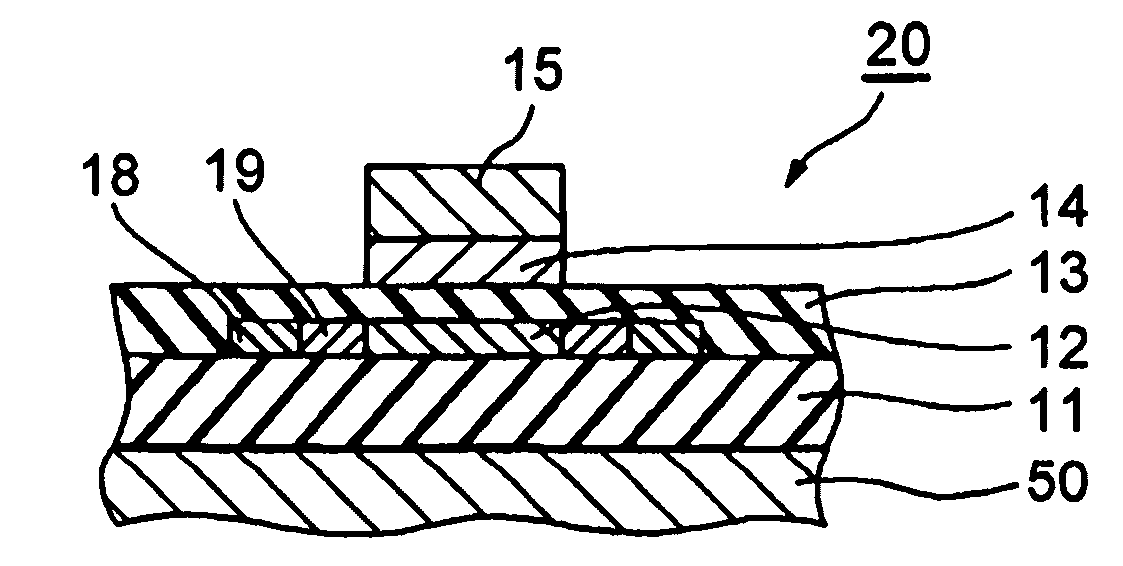Thin-film transistor and manufacturing method thereof
a thin film transistor and manufacturing method technology, applied in the field of thin film transistors, can solve the problems of large leakage current, decrease in throughput, and inability to use amorphous silicon thin film to form tfts, and achieve the effects of low leakage current amount, high contrast ratio of lcd, and high quality
- Summary
- Abstract
- Description
- Claims
- Application Information
AI Technical Summary
Benefits of technology
Problems solved by technology
Method used
Image
Examples
example 1
[0062]An LDD-TFT was manufactured according to the first embodiment. As insulating substrate 50 was used as a low-temperature glass, “OA-2 substrate” from Nippon Electric Glass Co., Ltd. A silicon dioxide thin film was deposited to a thickness of 300 nm on the low-temperature glass substrate as underlying insulating film 11 by using plasma CVD using a mixed gas of SiH.sub.4 and N.sub.2O as a raw-material gas. Then, an amorphous silicon thin film was deposited to a film thickness of 60 nm on underlying insulating film 11 by a reduced pressure CVD method using Si.sub.2H.sub.6 as a raw-material gas. The deposition was performed at a Si.sub.2H.sub.6 flow rate of 200 sccm under a pressure of 13 Pa at a substrate temperature of 450 degree C. for 50 minutes. After that, laser annealing was performed in which the amorphous silicon thin film was irradiated with a XeCl excimer laser beam with a wavelength of 308 nm to crystallize the amorphous silicon thin film, thereby forming a polysilicon ...
example 2
[0075]An LDD-TFT was manufactured according to the second embodiment.
[0076]As in Example 1, polysilicon thin film 12 was formed on a low-temperature glass substrate and was patterned into an island, and gate insulating film 13, microcrystalline silicon thin film 14A, and chromium thin film 15A were deposited. Then, a gate electrode was patterned as in Example 1. However, upper gate electrode 15 was overetched by using wet etching. The etchant used was an aqueous solution of diammonium cerium (IV) nitrate (Ce(NH4)2(NO3)6) and perchloric acid at room temperature and the etching was performed for 210 seconds. Photoresist film 16 used in the previous process was left and used to dry-etch lower gate electrode 14 under the same conditions used in Example 1. As a result, upper gate electrode 15 became narrower in width than lower gate electrode 14 by 1 μm on each side.
[0077]In this example, the amount of side-etching of the upper gate electrode was able to be increased by wet etching compa...
PUM
 Login to View More
Login to View More Abstract
Description
Claims
Application Information
 Login to View More
Login to View More - R&D
- Intellectual Property
- Life Sciences
- Materials
- Tech Scout
- Unparalleled Data Quality
- Higher Quality Content
- 60% Fewer Hallucinations
Browse by: Latest US Patents, China's latest patents, Technical Efficacy Thesaurus, Application Domain, Technology Topic, Popular Technical Reports.
© 2025 PatSnap. All rights reserved.Legal|Privacy policy|Modern Slavery Act Transparency Statement|Sitemap|About US| Contact US: help@patsnap.com



